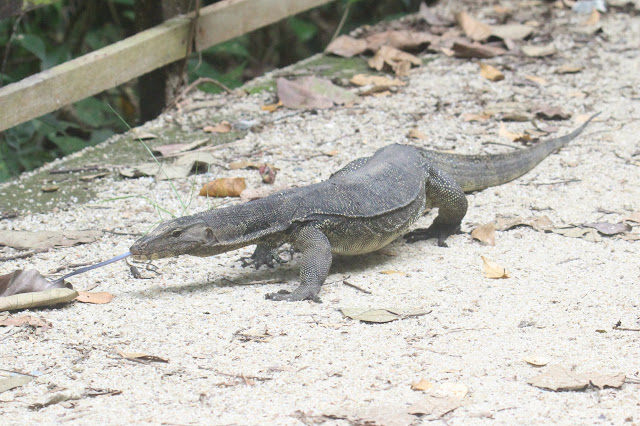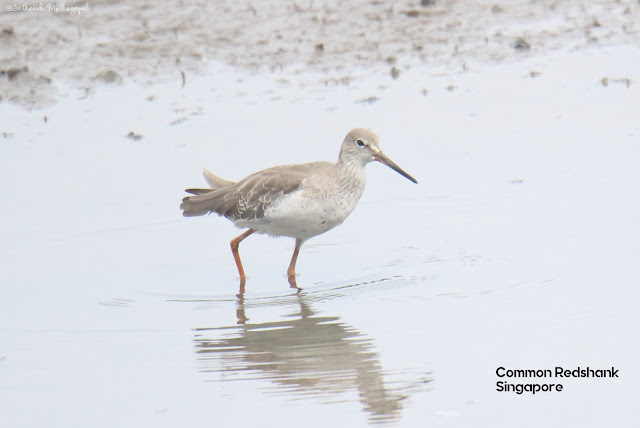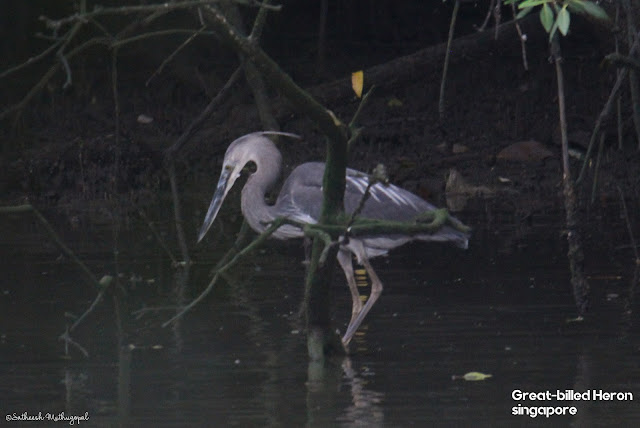It was early morning. I reached the Sungei Buloh Wetland Reserve situated in the north of Singapore. The mangrove forest welcomes us with the warning "Watch out for Crocodiles". I started walking on the trail, observing birds. There were only a couple of people ahead of me. The place was very calm except for the bird calls and the sound of breeze. I stopped and focused on a grey heron with my camera, looking through the viewfinder with one eye. I felt something big moving next to me and, turning, saw a Smooth-coated Otter.
Smooth-coated Otters thrive in many places in Singapore. They co-exist with human settlements too. The mangrove habitats with a rich prey source help them survive. During my walk, I also found a few Saltwater crocodiles basking on the shore; this species is found across Southeast Asia and the eastern coastal region of India and north Australia. I had a similar experience of watching crocodiles in a birding spot in the Ranganthittu bird sanctuary, near Mysore, in India. I had taken a boat ride to watch birds and watched freshwater crocodiles basking on the rocks.
Without waiting further, I continued on the nature trail and encountered a Malayan Water Monitor right on the path. I stopped walking and waited for its response. It stopped walking towards me and lay down. I waited for a couple of minutes. A group of local people walked past it keeping a safe distance, and I followed them. This Monitor species is common in Singapore and it seems to be habituated to human presence.
This Sungei Buloh Wetland Reserve attracts migratory birds from east Asia and Siberia. Considering the east Asian and Australasian flyways, this Reserve is one of the important spots for migratory birds. Some of the migratory birds use this place as a stopover to get energized and fly further; this Reserve plays a major role in birdlife. As part of it’s research on migratory birds, the Center catches and bands the migratory birds with a green over white flag which is the assigned color for Singapore as per the shorebird flagging protocol. A common redshank with a Singapore tag was found in Qinghai lake in China in 2012. When I went birding I saw the Common Redshank tagged with the Singapore color. Most likely it was tagged previously and returned this year.
Mudskipper and Telescope snails are evidence of the healthy mudflats in the reserve. The Great-billed Heron is one of the largest birds in Singapore which can be seen in the mudflats. This is a resident bird of southeast Asia and is mainly found in the coastal regions. The complex root system of mangrove trees is a suitable breeding place for many fish species, and I saw an abundant amount of fish in the river and shallow water. Archerfish is one of them which can be seen in this Reserve. They shoot water on bugs to catch them.
It was September. I saw several migratory bird species arrive for winter. Along with many wetland migratory species like the Common Sandpiper, the Pacific Golden Plover, the Whimbrel, and the Common Redshank, I found a Terek Sandpiper. This species got its name because of its breeding ground in the Terek river. Unlike other sandpipers, they don't migrate inland but choose the shores of Africa, Southeast Asia, and Australia.
In Singapore, epiphytes are common on many tropical trees. When I came out of the Reserve, I saw a group of people taking photographs of epiphytes. I was surprised to know that the Buffy Fish Owl hiding within them. I waited and saw the bird pop out; these plants probably provide good protection, even a possible nesting site.
Though this Reserve is well protected, most of the mudflats and wetlands in the world are under severe threat. The development of nearby areas is a pressure on the wetlands. Mudflats like Sungei Buloh are very important places for migratory birds, providing a stopover place for birds going further south. If such places are destroyed or polluted the bird migration routes that were followed for millions of years will be severely affected. It’s like running out of fuel on a highway and the only fuel station that was available is no more.
Article Published in Leaf Litter Magazine Mar 2023. ©Satheesh Muthu Gopal
Read More Articles :
- The Remaining Grasslands of Palani hills
- The Gateway to Paradise
- Reflections from a museum [Zürich, Switzerland]
- Reclamation in Kuthiraiyar
- Palani Hills : Shrinking Heaven
- Painted Beauty
- Melodies of Bombay Shola
- Lunch with a Falcon
- Glatt : A Swiss River
- Fort Canning Park































14 Comments
Wow 😯 Excellent article with great information 🙏🏽
ReplyDeleteThanks Raj 😊
DeleteExcellent article 👏🏼👏🏼
ReplyDeleteThanks
Deleteஐயா நான் படிக்குமாறு தமிழில் இல்லையே
ReplyDeleteபல்லுயிர்களுக்கானது பூமி புத்தகத்தில் தமிழில் எழுதியிருக்கிறேன்.
Deleteநன்று.
ReplyDeleteThanks
DeleteWow, many interesting sightings!
ReplyDeleteThank you
Deleteநல்ல பதிவு, வாழ்த்துக்கள் சதீஷ்
ReplyDeleteThanks sir 😊
DeleteSuper thalaivare
ReplyDeleteThanks Guru 😊
Delete